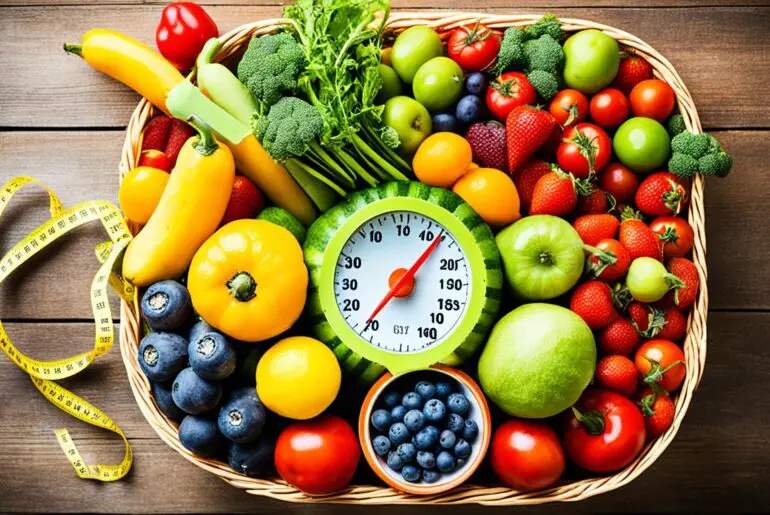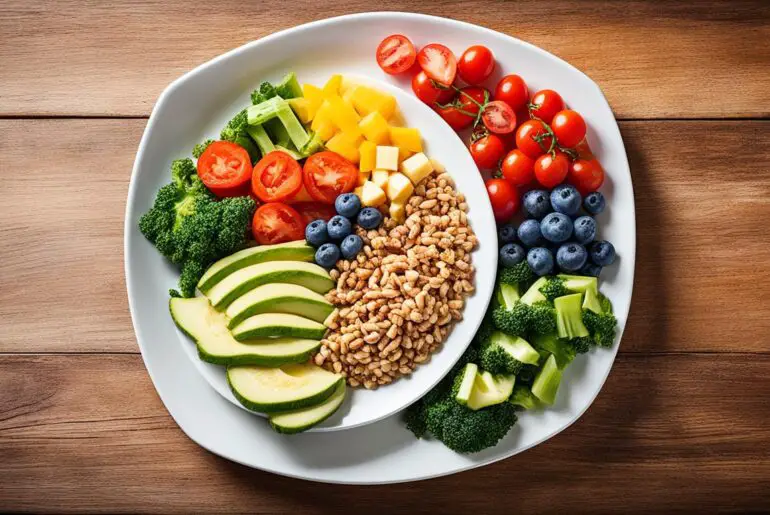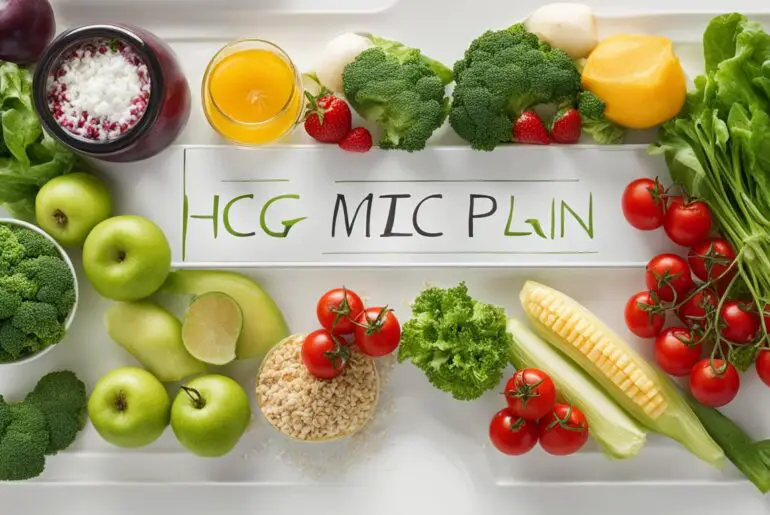Are you a vegetarian looking for an effective meal plan to achieve sustainable weight loss? The HCG Diet Phase 2 offers a solution that aligns with your ethical choices. Contrary to common belief, vegetarians can successfully follow this low-calorie regimen by making some simple substitutions in their meal plan. But the question is, how can vegetarians meet their recommended protein intake while following the HCG Diet Phase 2?
Key Takeaways:
- The HCG Diet Phase 2 can be adapted for vegetarians by replacing meat with vegetarian-friendly protein sources.
- Options for protein replacements include cottage cheese, tofu, legumes, eggs, and protein powder.
- Vegetables and fruits play a vital role in the vegetarian HCG Diet Phase 2, providing necessary nutrients.
- Carbohydrate options for vegetarians on the HCG Diet Phase 2 include breadsticks and melba toast.
- It is essential to pay attention to beverage choices, water intake, and approved seasonings while following this diet plan.
Vegetarian Types on the HCG Diet
When it comes to following the HCG Diet Phase 2 as a vegetarian, it is important to understand the different types of vegetarian diets and their exclusion of meat products. This knowledge will help you make informed choices and find suitable protein replacements according to your specific dietary preferences.
There are three main types of vegetarian diets:
- Vegan: Vegans exclude all animal products from their diet, including meat, dairy, eggs, and honey.
- Lacto-vegetarian: Lacto-vegetarians consume dairy products but avoid eggs and other animal meats.
- Lacto-ovo vegetarian: Lacto-ovo vegetarians include both dairy products and eggs in their diet but exclude other animal meats.
While following the vegetarian HCG Diet Phase 2, it is crucial to consider these differences. Vegans will need to find plant-based protein sources that do not include any animal products, while lacto-vegetarians can incorporate dairy-based proteins like cottage cheese. Lacto-ovo vegetarians have a wider range of protein options as they can include both dairy and eggs in their meal plan.
It is important to tailor your protein replacements for meat according to your specific type of vegetarian diet. This will ensure that you are meeting your nutritional needs while following the vegetarian HCG Diet Phase 2.
By understanding the types of vegetarian diets and the exclusion of meat products, you can make informed choices and create a meal plan that aligns with your dietary preferences and the HCG Diet Phase 2 requirements.
Protein Sources for Vegetarians on the HCG Diet

While following the HCG Diet Phase 2 as a vegetarian, finding alternative protein sources is crucial since meat is not allowed. Fortunately, there are several protein-rich options that can be incorporated into your meal plan to meet your dietary needs.
Cottage Cheese
Cottage cheese is a fantastic protein source for vegetarians on the HCG Diet Phase 2. With approximately 30g of protein per cup, it offers a substantial boost to your daily protein intake. This versatile dairy product can be enjoyed as a snack or incorporated into various dishes.
Tofu
Another excellent protein source for vegetarians is tofu. With approximately 20g of protein per cup, tofu provides a substantial amount of protein while being low in calories. Tofu can be used in stir-fries, salads, or even as a standalone protein option in your meal plan.
Legumes
Legumes, such as soy and pea protein, are great options for vegetarians on the HCG Diet Phase 2. They offer a rich source of protein, fiber, and nutrients. Incorporating legumes into your meal plan can help you meet your protein requirements while adding variety to your diet.
Eggs
Eggs are allowed on the HCG Diet Phase 2 and are a valuable protein substitute for vegetarians. With approximately 6g of protein per large egg, they can be incorporated into various dishes, such as omelets or egg salads, to enhance your protein intake.
Protein Powder
If you find it challenging to meet your recommended protein intake solely through food sources, protein powder can be a convenient solution. There are various vegetarian-friendly protein powders available, such as rice protein powder or vegan options like Sun-Warrior Protein or Garden of Life Raw Protein. These powders can be easily mixed into smoothies or used in recipes to supplement your protein needs.
By incorporating these protein sources into your vegetarian HCG Diet Phase 2 meal plan, you can ensure that you are meeting your protein requirements while enjoying a diverse and satisfying diet.
| Protein Sources | Protein Content per Cup |
|---|---|
| Cottage Cheese | Approximately 30g |
| Tofu | Approximately 20g |
| Legumes (Soy and Pea Protein) | Varies |
| Eggs (1 large egg) | Approximately 6g |
| Protein Powder | Varies |
Note: Protein content may vary depending on the brand and specific product.
Vegetables and Fruits on the Vegetarian HCG Diet
As part of the vegetarian HCG Diet Phase 2, incorporating vegetables and fruits into your meal plan is crucial for a balanced diet. Each meal should include one serving of vegetables, which can be consumed either raw or cooked. Some nutritious vegetable options that you can enjoy include:
- Spinach
- Tomatoes
- Celery
- Onions
- Cucumbers
- Lettuce
- Cabbage
These vegetables are not only low in calories but also rich in essential vitamins, minerals, and fiber, which are beneficial for your overall health and well-being.
In addition to vegetables, the vegetarian HCG Diet Phase 2 allows for two servings of high-protein fruits per day. These fruits not only provide a sweet and refreshing taste but also contribute to your daily protein intake. Here are some high-protein fruits that you can incorporate into your diet:
- Guava
- Avocado
- Orange
- Fig
- Mango
These high-protein fruits are a great way to satisfy your sweet cravings while still adhering to the vegetarian HCG Diet Phase 2 guidelines. They provide essential nutrients and can help keep you feeling fuller for longer.
Remember, including a variety of vegetables and fruits in your meal plan is key to obtaining a wide range of nutrients and maintaining a healthy diet while on the vegetarian HCG Diet Phase 2.
Carbohydrate Options for Vegetarians

When following the vegetarian HCG Diet Phase 2, it is important to include a serving of carbohydrates with each meal. However, not all carbohydrate options are suitable for this diet. Instead, focus on incorporating specific choices that align with the HCG Diet guidelines.
For vegetarians on the HCG Diet Phase 2, the recommended carbohydrate options include:
- Breadstick: A single breadstick is allowed as a carbohydrate serving. Choose a plain breadstick without any additional flavors or seasonings.
- Melba Toast: Another suitable option is melba toast. Similar to the breadstick, opt for plain and unflavored melba toast.
It is important to note that regular bread and crackers should be avoided while on this diet. Stick to the specific carbohydrate options mentioned above to stay within the recommended calorie intake and ensure optimal results.
To offer a visual illustration of the suitable carbohydrate options, the table below outlines the nutritional information for one serving of breadstick and melba toast:
| Carbohydrate Options | Calories | Carbohydrates (grams) | Fat (grams) | Protein (grams) |
|---|---|---|---|---|
| Breadstick | 100 | 22 | 1 | 3 |
| Melba Toast | 60 | 13 | 0 | 2 |
By selecting the appropriate carbohydrate options and incorporating them into your meals, you can maintain a balanced intake of nutrients while following the vegetarian HCG Diet Phase 2.
Beverages and Seasonings for Vegetarians on the HCG Diet
When following the vegetarian HCG Diet Phase 2, it is essential to pay attention to the beverages and seasonings you consume. Let’s explore the approved options that will keep you refreshed and satisfied throughout your weight loss journey.
Beverages
As a vegetarian on the HCG Diet Phase 2, you have a variety of beverage choices. Here are the beverages you can enjoy:
- Tea: Green tea, herbal tea, and black tea are all allowed.
- Coffee: You can have regular coffee or opt for decaffeinated if you prefer.
- Mineral Water and Spring Water: These refreshing options can be consumed in any quantity.
Staying hydrated is crucial for your overall well-being while on the diet. It is recommended to consume at least 75 ounces of water per day to support proper bodily functions and aid in weight loss.
Seasonings
Seasonings add flavor and excitement to your meals while on the HCG Diet Phase 2. Here are some approved seasonings you can incorporate into your vegetarian meals:
- Lemon Juice: A tangy and refreshing addition to salads and dressings.
- Garlic: Adds a savory taste to your dishes.
- Thyme and Parsley: These herbs enhance the flavor of various dishes.
- Vinegar: Apple cider vinegar and white vinegar are both suitable options.
- Sea Salt: Enhances the taste of your meals while keeping sodium intake in check.
- Basil and Pepper: Adds a burst of flavor to soups, stews, and salads.
- Soy Sauce: Provides a rich umami flavor to stir-fries and Asian-inspired dishes.
- Pickles: Adds a tangy and crunchy element to your meals.
With these seasonings at your disposal, you can elevate the taste of your vegetarian meals while staying within the guidelines of the HCG Diet Phase 2.
| Beverages | Seasonings |
|---|---|
| Tea | Lemon Juice |
| Coffee | Garlic |
| Mineral Water | Thyme and Parsley |
| Spring Water | Vinegar |
Protein Replacements for Vegetarians on the HCG Diet

As a vegetarian on the HCG Diet Phase 2, you may be wondering how to find suitable protein replacements. Fortunately, there are various options available to ensure you meet your protein needs while following the diet.
Protein Powders
A convenient way to increase your protein intake is through protein powders. Rice protein powder, as well as vegan options like Sun-Warrior Protein or Garden of Life Raw Protein, can be incorporated into your diet. These powders are easy to use and provide a concentrated source of protein.
Dairy Substitutes
If you prefer dairy alternatives, there are several options to choose from. Vegan cottage cheese is a great substitute for traditional cottage cheese, providing protein without the animal products. Additionally, there are egg replacers available for those looking to avoid eggs while still obtaining protein.
Veggie Burgers
Veggie burgers can be a delicious and protein-rich addition to your meals. Look for options that are made without grains or starchy fillers to minimize carbohydrate intake. These burgers often contain soy products or other plant-based protein sources and can be a satisfying alternative to meat.
Soy Products, Beans, Legumes, and Seeds
Don’t forget about the wide variety of vegetarian protein sources available in the form of soy products, beans, legumes, and seeds. Incorporating tofu, tempeh, soy milk, and edamame into your meals will provide a substantial amount of protein. Additionally, options like lentils, chickpeas, black beans, chia seeds, and hemp seeds offer essential amino acids and fiber.
By diversifying your protein sources and incorporating these alternatives into your meal plan, you can meet your protein requirements while following the vegetarian HCG Diet Phase 2.
Remember, it’s essential to consult with a healthcare professional or registered dietitian before making any significant dietary changes or embarking on a new weight loss program.
Additional Tips for Vegetarians on the HCG Diet

When following the HCG Diet Phase 2 as a vegetarian, there are a few additional tips that can enhance your weight loss journey. Incorporating probiotics into your diet can help control gut bacteria and reduce food cravings.
It is crucial to read labels carefully and choose products with minimal sugar and fat content. Opting for clean label products, which contain fewer artificial additives and preservatives, can further support your weight loss goals.
Here’s a table highlighting key recommendations for a successful vegetarian experience on the HCG Diet Phase 2:
| Additional Tips | Benefits |
|---|---|
| Include probiotics in your diet | Helps control gut bacteria and food cravings |
| Read labels and choose low sugar and fat products | Aids in maintaining a healthy calorie intake |
| Opt for clean label products | Reduces exposure to artificial additives and preservatives |
By following these additional tips, you can enhance your vegetarian weight loss journey on the HCG Diet Phase 2, optimizing your nutrition and achieving your desired results.
Transitioning After the Vegetarian HCG Diet

After completing the vegetarian HCG Diet Phase 2, it is essential to transition properly to maintain the weight loss and support your overall health. This transition period is crucial for your metabolism to fully reset, which typically takes about nine months. During this phase, the goal is to gradually increase your calorie intake while ensuring you meet your protein needs and make necessary meal modifications.
One important consideration during the transition period is avoiding protein deficiency. As a vegetarian, it’s crucial to find suitable protein sources to replace the protein you were getting from meat. Legumes, such as lentils, chickpeas, and beans, can be excellent options for vegetarians as they offer a good amount of protein. Organic full-fat dairy products like Greek yogurt and cottage cheese can also provide a protein-rich addition to your meals.
Gradually increasing your calorie intake is another aspect of transitioning after the vegetarian HCG Diet. During the diet phase, you were following a low-calorie regimen, and suddenly increasing your calorie intake can lead to weight gain. It’s important to do this gradually, adding calories slowly week by week, to prevent any drastic weight fluctuations.
“Transitioning from the vegetarian HCG Diet Phase 2 requires a careful balance of meeting your protein needs, gradually increasing your calorie intake, and making meal modifications that suit your preferences and needs.”
Meal modifications may be necessary based on your personal preferences and dietary needs. For example, you may choose to include a variety of vegetables, whole grains, and plant-based fats in your meals to ensure a balanced diet. Listening to your body and making adjustments as needed will help you create a sustainable eating plan post-diet.
Remember to focus on consuming nutrient-dense foods, including a variety of fruits and vegetables, healthy fats, and adequate protein to support your body’s needs. Regular exercise and staying hydrated are also essential components of a healthy lifestyle.
Transitioning after the vegetarian HCG Diet Phase 2 is a critical phase to ensure long-term success and maintain the results you achieved during the diet. By gradually increasing your calorie intake, addressing protein deficiency, and making meal modifications, you can continue on your weight loss journey while nourishing your body with the nutrients it needs.
Conclusion
The vegetarian HCG Diet Phase 2 is a weight loss program that offers a sustainable solution for individuals seeking long-term results while adhering to vegetarian-friendly options. By following the recommended meal plan and making suitable substitutions, vegetarians can achieve their weight loss goals without compromising their ethical choices.
Weight loss programs like the HCG Diet Phase 2 provide the necessary support and guidance to ensure successful weight loss and maintenance. With the inclusion of vegetarian-friendly protein sources, such as cottage cheese, tofu, legumes, and eggs, individuals can meet their recommended protein intake and stay on track with their weight loss journey.
With its emphasis on sustainable weight loss and vegetarian-friendly options, the HCG Diet Phase 2 is accessible to a wider range of individuals seeking to achieve their weight loss goals. Whether it’s for ethical reasons or personal preference, vegetarians can confidently embark on this program, knowing that it aligns with their dietary choices and offers a pathway to long-term success.
FAQ
Can vegetarians follow the HCG Diet Phase 2?
Yes, vegetarians can follow the HCG Diet Phase 2 by making some substitutions in the meal plan.
What are the different types of vegetarian diets?
There are different types of vegetarian diets, including vegan, lacto-vegetarian, and lacto-ovo vegetarian.
What are some protein sources for vegetarians on the HCG Diet Phase 2?
Protein sources for vegetarians on the HCG Diet Phase 2 include cottage cheese, tofu, legumes, eggs, and protein powder.
What vegetables and fruits can vegetarians consume on the HCG Diet Phase 2?
Vegetarians on the HCG Diet Phase 2 can consume various vegetables such as spinach, tomatoes, celery, onions, cucumbers, lettuce, and cabbage. They can also have high-protein fruits like guava, avocado, orange, fig, and mango.
What carbohydrates are allowed for vegetarians on the HCG Diet Phase 2?
Vegetarians on the HCG Diet Phase 2 can have one serving of carbohydrates per meal, such as one breadstick or one melba toast.
What beverages and seasonings can vegetarians on the HCG Diet Phase 2 consume?
Vegetarians on the HCG Diet Phase 2 can drink tea, coffee, mineral water, and spring water. They can use Stevia as a sweetener and seasonings like lemon juice, garlic, thyme, parsley, vinegar, sea salt, basil, pepper, soy sauce, and pickles.
What are some protein replacements for vegetarians on the HCG Diet Phase 2?
Protein replacements for vegetarians on the HCG Diet Phase 2 include protein powders, dairy substitutes, veggie burgers, soy products, beans, legumes, and seeds.
Are there any additional tips for vegetarians on the HCG Diet Phase 2?
Yes, vegetarians on the HCG Diet Phase 2 should include probiotics in their diet, choose products with minimal sugar and fat content, read labels, and opt for clean label products.
How can vegetarians transition after completing the HCG Diet Phase 2?
After completing the HCG Diet Phase 2, vegetarians can gradually increase calorie intake, include legumes or organic full-fat dairy products, and make necessary meal modifications based on individual preferences and needs.
Is the HCG Diet Phase 2 a sustainable weight loss solution for vegetarians?
Yes, the HCG Diet Phase 2 offers a sustainable weight loss solution for vegetarians. It provides support and guidance for long-term results and includes vegetarian-friendly options.




